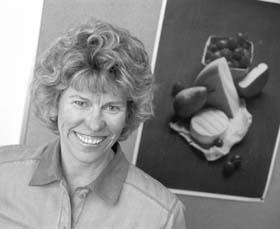
| ||
 | ||
 Linda Jacobs Starkey PHOTO: OWEN EGAN |
Young and educated use food banks
|
BRONWYN CHESTER | Since the recession of the early '80s, foodbanks have become a permanent fixture in the gamut of social services. Yet, while approximately two thirds of a million Canadians use this food service on a regular basis, little is known about this growing sector of the population.
Who uses food banks? What is the state of their health? How do they feel about using a food bank? These are a few of the questions posed by Linda Jacobs Starkey to 490 users interviewed in 20 food banks in the Montreal area. Starkey is a lecturer and PhD candidate in the School of Dietetics and Human Nutrition. To the uninitiated, Starkey's most surprising find, published recently in The Canadian Medical Association Journal, was the relative youth, good health and high education level found among users. The mean age of food bank users is 41 years, most receive social assistance (83.5%) and many were university educated or had completed technical school (41%). In fact, food bank users tend to be better educated than the population at large. Starkey herself wasn't completely surprised by the results of her first-of-its-kind survey. Having worked with a number of Montreal food assistance programs -- such as soup kitchens and food banks -- she noticed that the clientele she was seeing didn't entirely match the portrait of poverty painted in the media. "Like everyone, I read about the poverty of single-parent women and old people, but they aren't who I was seeing at the food banks," she says, adding that the nature of food bank-style food distribution may not be appealing to older people and single parents. Food banks hand out bags of food which may be heavy for the elderly and cumbersome for a mother with young children, Starkey says. Lunch programs and community breakfasts may be more suitable for the elderly and for families, respectively. Her study pointed to few differences between men and women with one noteworthy exception -- female food bank users are much more likely to cook, something that gives them an edge in making their food last longer. Non-Canadians -- recent immigrants, for instance -- outscored Canadians when it came to cooking. "It has to do with the habits of cooking and shopping you bring with you," says Starkey. Encouraging food bank users to cook more, to make their limited food budgets go farther, is something done at some of the smaller food banks, says Starkey, where courses in food preparation may be offered. But she believes that many of the people she interviewed would know how to prepare good meals, "they just don't have the means." The mean monthly income of the interviewees was less than $900. It is perhaps not surprising, therefore, that most of the people interviewed responded that they felt no embarrassment in using a food bank, seeing it, rather, as a "community resource." Starkey believes that, nationally, we need to take a closer look at the question of food security, something she defines as "having access at all times to personally acceptable food in sufficient quantity and in a personally acceptable manner." We still don't have much data about who is using what kind of food assistance programs and why, and whether they are getting sufficient quantity and quality of food, says Starkey. While most of the people she interviewed said they felt that they were in good health, it won't be until Starkey has finished analyzing the dietary intake of the research subjects that she will be able to assess the long-term nutritional health consequences based on their actual food intake. She wants to know if they are at risk for health problems, based on their dietary status. Starkey notes in the article that "the overall health of a population is better when the gap between rich and poor is narrow.... Rates of illness are higher among lower-income Canadians, they have fewer disability-free years and they are more likely to have behaviour-related risk factors for disease." In Canada, that gap between rich and poor is growing. And while food banks are one measure to redress the gap, Starkey notes that they don't necessarily ensure sufficient nutrition. A Toronto survey that she cites in the article indicates that 23% of food bank users ran out of food every month.
|
|
| |||||